At the end of August, Scott Parker was sacked by Bournemouth after a 9-0 drubbing at the hands of Jürgen Klopp’s Liverpool. Now, almost exactly four months later, the Englishman has been hired as manager of current Belgian champions Club Brugge after their sacking of Carl Hoefkens.
The former Tottenham Hotspur player has had success promoting both Bournemouth and Fulham to the Premier League and now gets to manage Club Brugge in the Champions League round of 16 against Portuguese heavyweights Benfica.
This tactical analysis article will look at what Club Brugge fans should expect from their side under Parker’s management.
Parker’s preferred formations
Scott Parker has been thrown straight into the deep end at Club Brugge, with the Englishman’s first match in charge of the Belgian giants against current leaders Genk. Club Brugge currently sit 12 points behind the leaders, so three points are a necessary aim. With that being said, Parker does not have much time on the training pitch to start to get his ideas across to the players.
When looking back at Parker’s spells in charge of both Bournemouth and Fulham in the Premier League and Championship, he will alternate between both a back three and back four system. Usually, he prefers setting his sides up in either a 4-2-3-1 or a 4-3-3, while a 3-5-2 or 3-4-1-2 is also possible. It will be interesting to see how he sets up the Belgian side, with either option a possibility. Carl Hoefkens normally utlilised a 4-3-3, while his predecessor Alfred Schreuder normally preferred some variation of a back three system. The following sections of this tactical analysis and scout report will now anlayse some tactical trends from Parker, which should give a basis for what Club Brugge fans should expect.
Strategic pressing strategy
One thing that Club Brugge fans should expect to see from Scott Parker is an implementation of a system that defends on the front foot. This includes defending from the front, with the forwards expected to press the opposition defenders in possession, as well as the defensive line keeping a high line at times. Looking back at the PPDA of the Bournemouth and Fulham sides he has managed shows this tactical trend.
With Bournemouth in the 2021/22 Championship season, Parker’s side averaged a PPDA of 8.72. This was lower than the year before his arrival, with the Cherries having a PPDA of 10.79 in the 2020/21 season, showing an increase in pressing in the opponent’s defensive third when Parker arrived. With Fulham in the Championship, Parker’s side had a PPDA of 9.44. The Premier League equivalent of these numbers is substantially higher, but this is due to a tendency of his sides sitting off more against usually far superior opposition.
Under Carl Hoefkens, Club Brugge also pressed at times, with their PPDA sitting at 10.19 with him in charge. It is very similar to the PPDA numbers that Scott Parker has averaged at his other managerial stops, but this section will now go more into detail about Parker’s style of pressing.
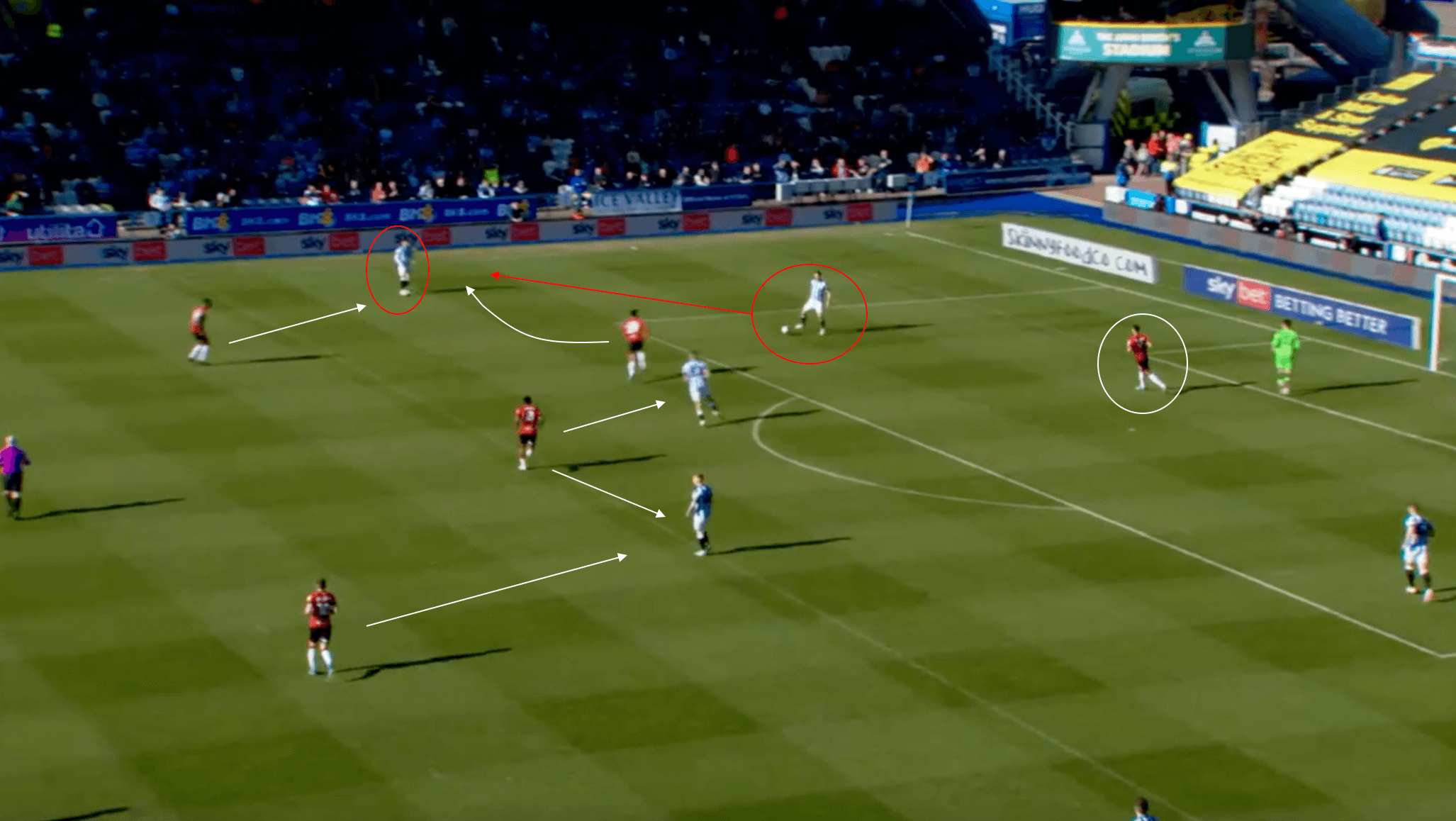
The image above shows an example of Scott Parker’s pressing style from Bournemouth’s Championship match last season against Huddersfield Town. In this phase of play above, Huddersfield are looking to build out from the back after the goalkeeper receives possession. As he gathers possession, the circled Bournemouth forward is able to put pressure on him, forcing him to pass to the centre-back inside the penalty box. Now, the goal for Parker’s side is to keep the ball to one side and not allow the opposition to switch the play and escape the press.
They are able to succeed, with the forward cutting off the pass back to the goalkeeper, and at the same time making it risky to try and play a pass across the box to the opposite centre-back. The movements of the other advanced players prevent the pass also being played centrally, which means the only option is for the central defender to play the pass out to the fullback.
This allows Bournemouth to then close down and engage the fullback, with them realising this is the only free passing option for the defender other than going long. As a result, the fullback is instantly closed down before the ball reaches him, which allows the Bournemouth players to regain possession and start a very advanced counterattack with numbers up just outside the Huddersfield penalty box.
This example is able to perfectly illustrate what Scott Parker wants his sides to do when in pressing situations, force the ball to one side and keep it there, rather than just press uncontrollably with no plan whatsoever.
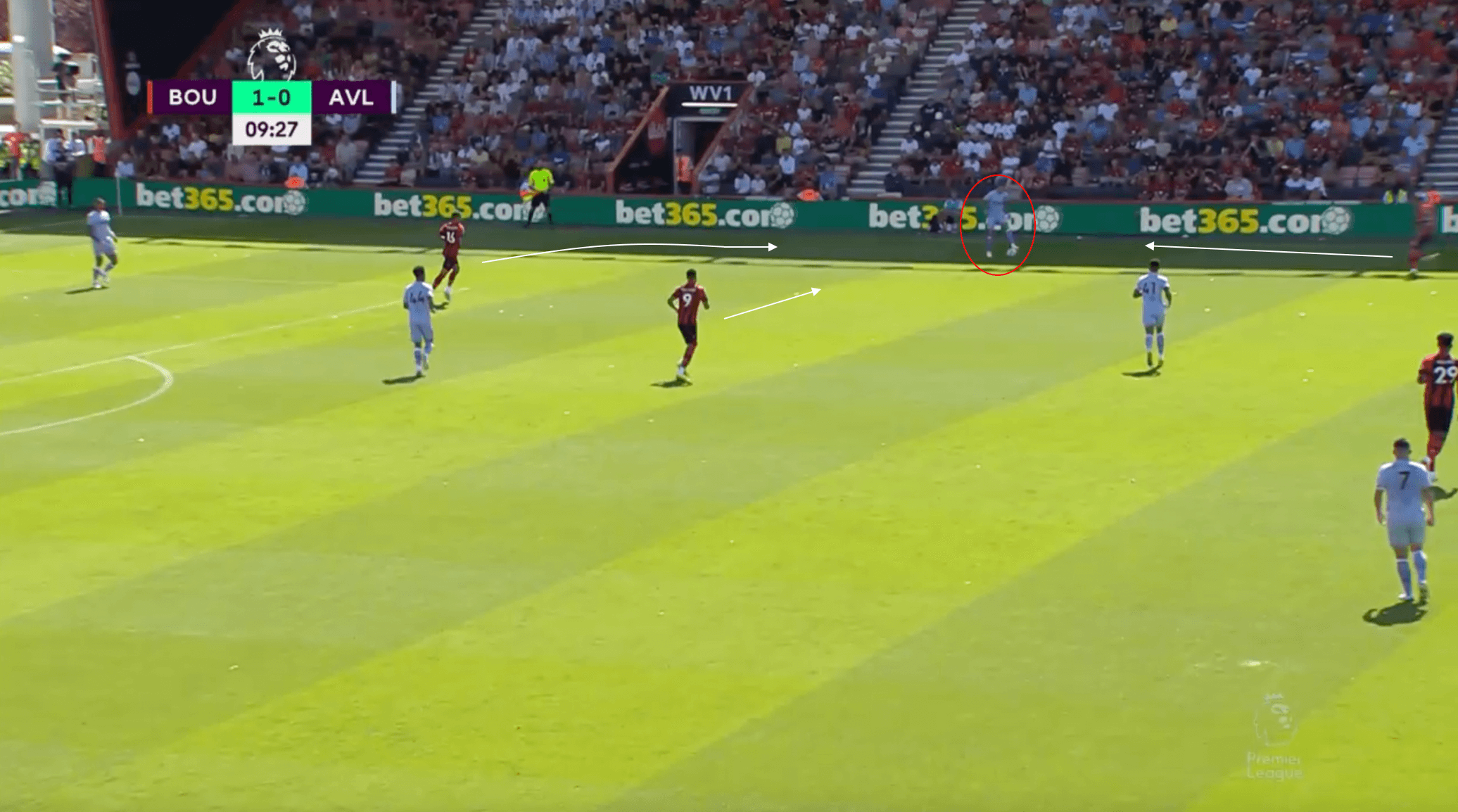
The image above shows another example of Parker’s Bournemouth side closing down the ball carrier once it is forced to one side. In the phase of play above, after the Villa goalkeeper plays the ball to the left-sided centre-back, Bournemouth look to pressure the ball, with the striker bending his run, closing off other passing lanes and forcing the defender to play the ball to one side. This is what occurs, with the ball being played out wide to the left back.
As soon as the pass is played, the Bournemouth press activates, with three players closing down the fullback from different angles. This limits any passing options that he has, as well as the ability to have time to play a cross-field pass to switch the play. As a result, the Bournemouth press works, with them regaining possession in an advanced area of the pitch to begin an attacking sequence of play.
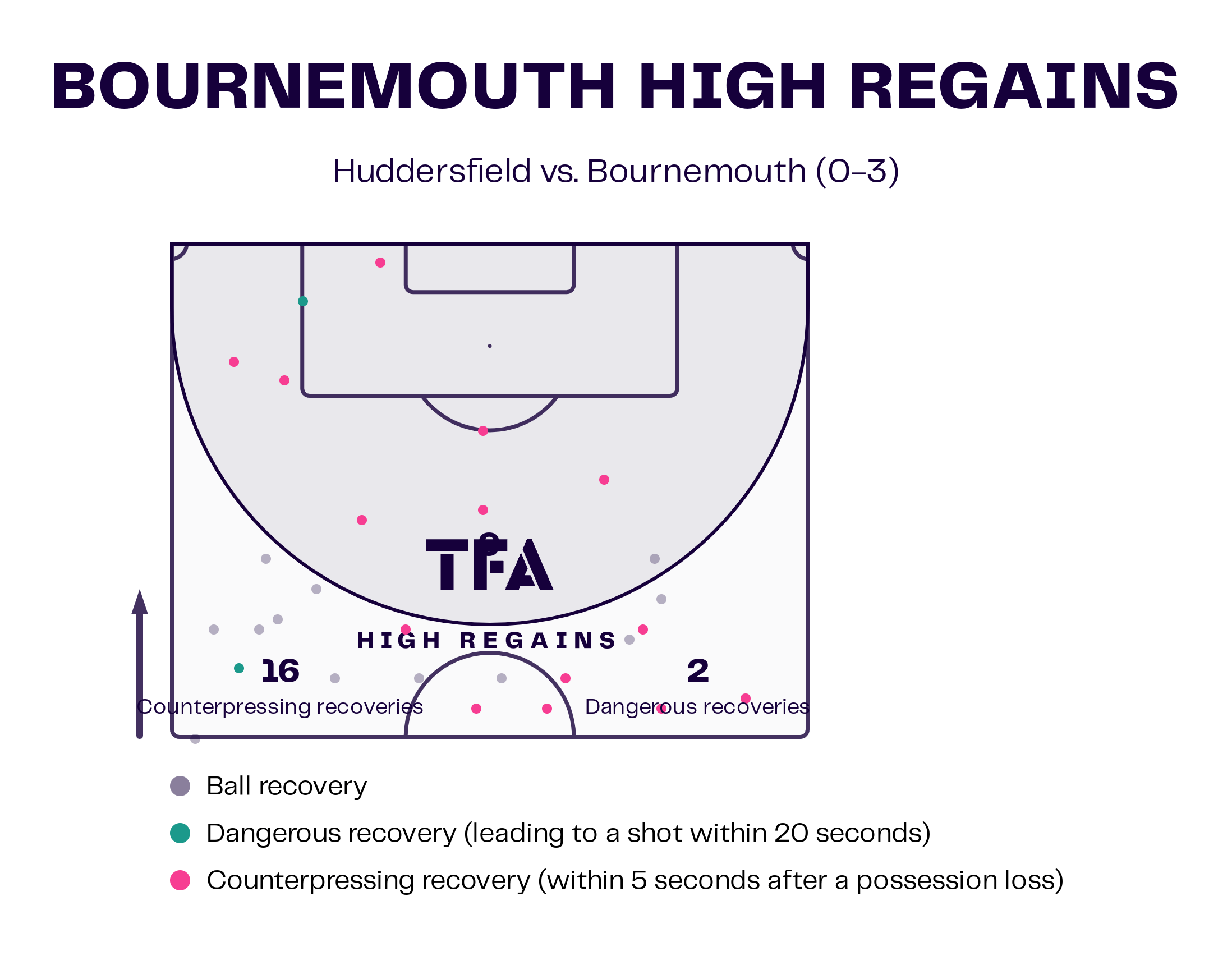
The data viz above shows the high regains and pressing actions from Bournemouth’s match against Huddersfield that the first example image is from. As we can see, Scott Parker’s sides are not necessarily high pressing, rather they press strategically, looking for openings where they have a high percentage probability of winning back possession. They do often look to press in the wide areas more than centrally, with this part of the strategy of pinning the ball to one side first before engaging. At Club Brugge, this will likely be the pressing strategy he employs.
Wide play when attacking and pushing numbers forward
When it comes to looking at how Scott Parker likes his sides to attack, one thing is clear. The Englishman likes his wide attackers to keep the width to stretch the opposition’s backline and open spaces centrally. When playing with two strikers up top, the same is true, with the forwards moving wide at times to receive possession and stretch opposition defences. These attacking tactics worked well during Bournemouth’s promotion campaign from the Championship in the 2021/22 season, with them finishing as the second-highest goalscorers in the division, only behind league winners Fulham.
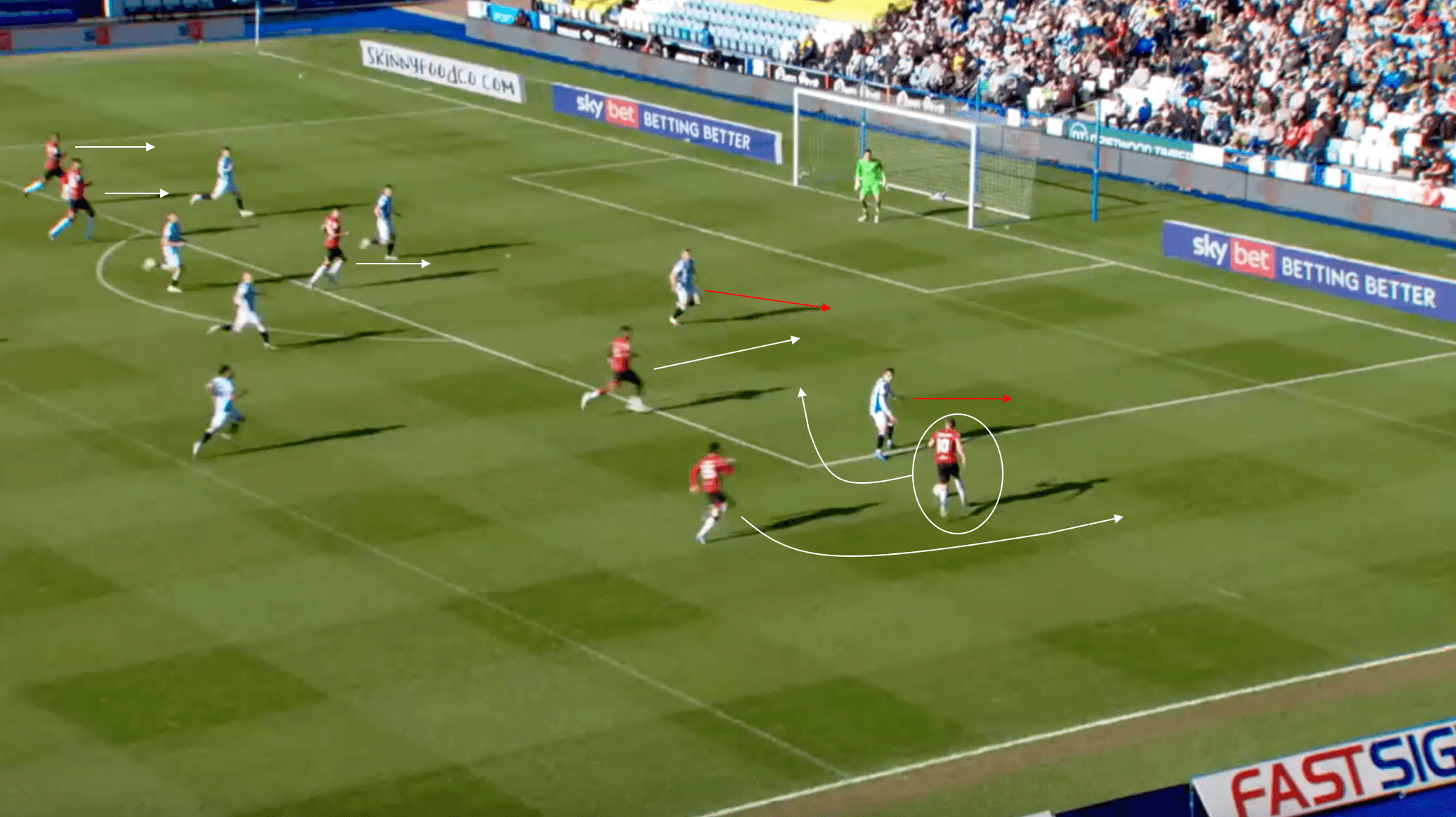
The image above shows an example of these attacking principles on display by Scott Parker’s Bournemouth side. The ball is played wide to former Celtic player Ryan Christie, who keeps the width to attempt to stretch the Huddersfield backline. As Christie advances into the penalty box, notice the Bournemouth players racing forward to join the attack and get into the box.
On the far side, three Bournemouth players have ventured into the penalty box, while on the near side, Christie is joined by both the fullback making an overlapping run and a midfielder making an underlapping run into the penalty box. These two runs are able to attract the attention of the Huddersfield defenders and drag them out, which allows Christie to cut inside and drive into the penalty box. Unfortunately, he is dispossessed by one of the opposition defenders. However, the loose ball is pounced on by an advanced Bournemouth player, and the attack is able to continue and be dangerous because of the numbers advanced by the Cherries.
These overlapping and underlapping runs by the Bournemouth players also allowed Scott Parker’s side to create a 3v2 overload down this flank, giving Bournemouth numerical superiority in this advanced area.
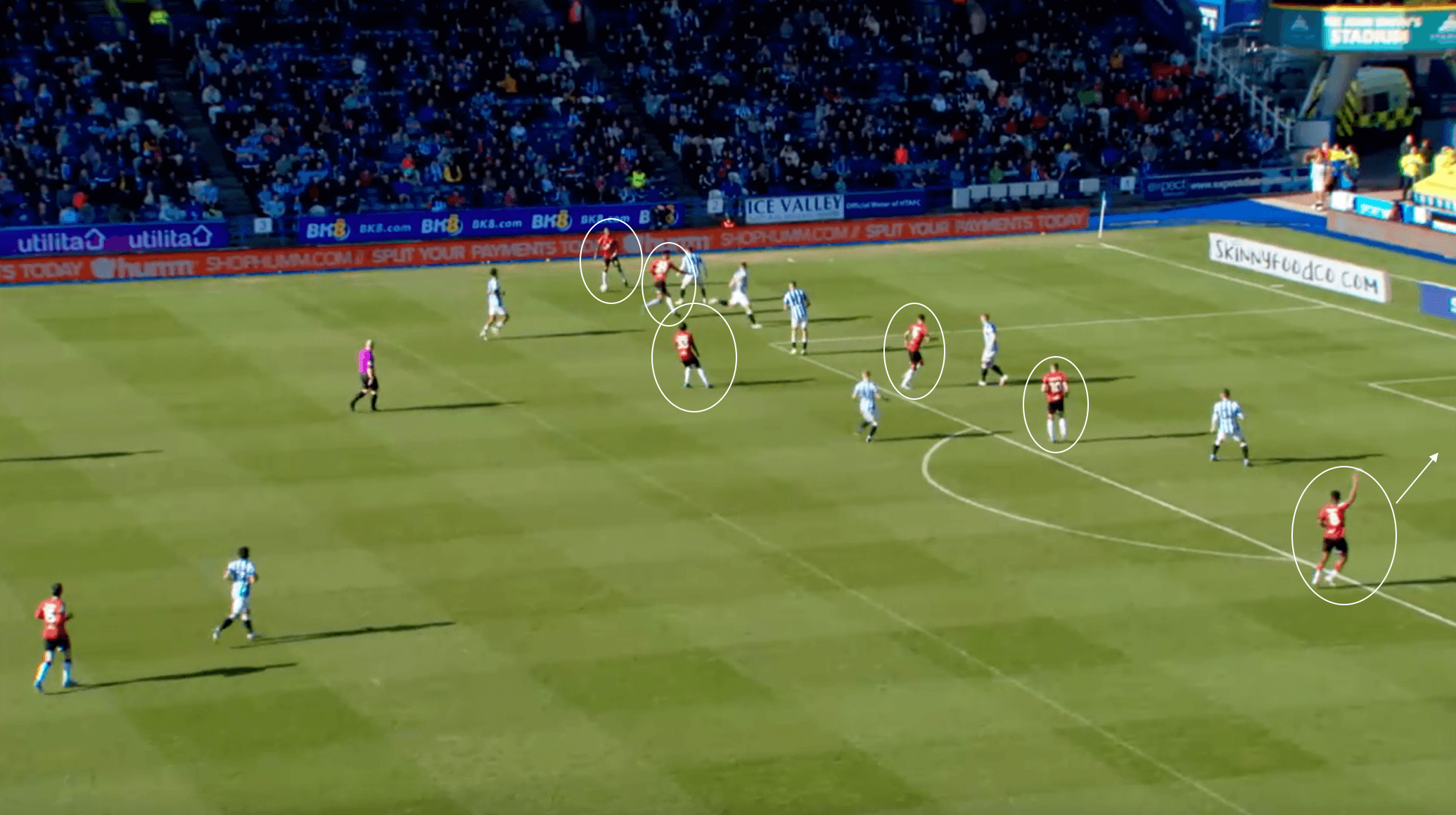
The image above shows another example of Parker’s tactics of attacking with width and numbers forward in attack creating a potential golden opportunity to score. In the phase of play above, six Bournemouth players have joined the attack and are positioned just inside or just outside the penalty box, with them being numbers even with the Huddersfield defenders. With them attempting to create an overload on this far touchline, it pulls the opposition defence towards this side, allowing the vacated space on the near side of the penalty box.
As this example shows, the Bournemouth player on the opposite side is unmarked and calling for the pass. The fullback does attempt to play this pass, but it is blocked by one of the Huddersfield defenders, eliminating the chance. Even though the unmarked player is not found, it still demonstrates what Parker attempts to do tactically with his sides in the final third of the pitch.
Conclusion
This tactical analysis piece has been able to show a slight look into the tactics of Scott Parker, but there may be some changes that he implements at Club Brugge. The strategic pressing style of Parker’s sides, using the width to stretch the opposition backlines, as well as attacking with plenty of numbers going forward, should be key trends to watch out for.
For many, Club Brugge hiring Scott Parker was somewhat out of the blue, so it will be very interesting to see how he does with the Belgian champions for the rest of this season, as well as his managerial debut in the UEFA Champions League.



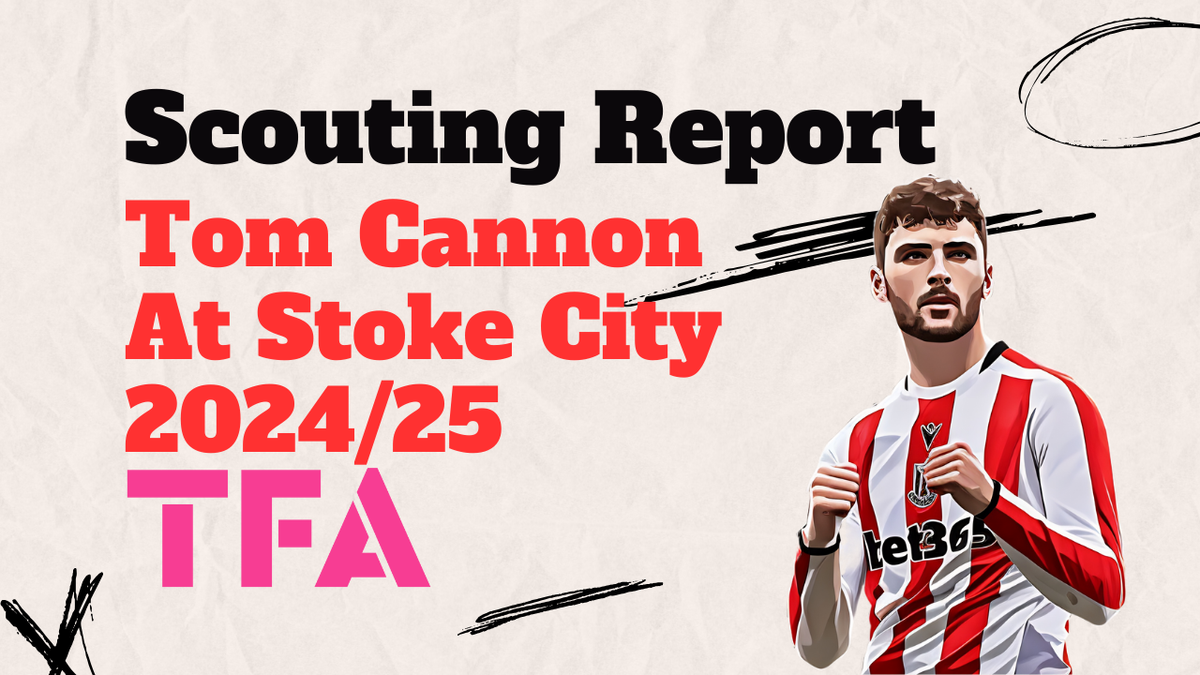

Comments